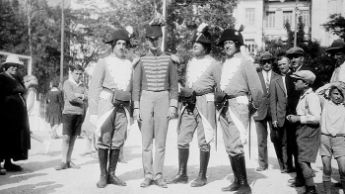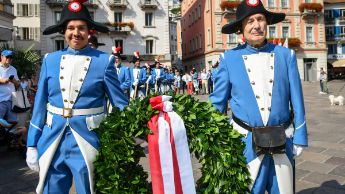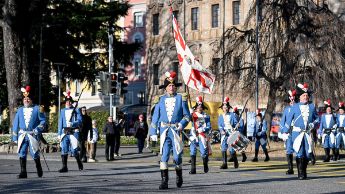Historical milestones
The oldest association
With over 220 years of history, the Corpo Volontari Luganesi (CVL, historic volunteer militia of Lugano) is the city’s oldest association. Founded in 1797 as a defence force against Napoleonic troops, it has served since 1928 as the Guard of Honour of the City of Lugano and takes part in the most significant commemorative events. Its fame and longevity stem from the fact that, on the night of 14–15 February 1798, it routed the Cisalpine attack during what later became known as the Moti Luganesi. This victory laid the foundations for Ticino to join the Swiss Confederation five years later.
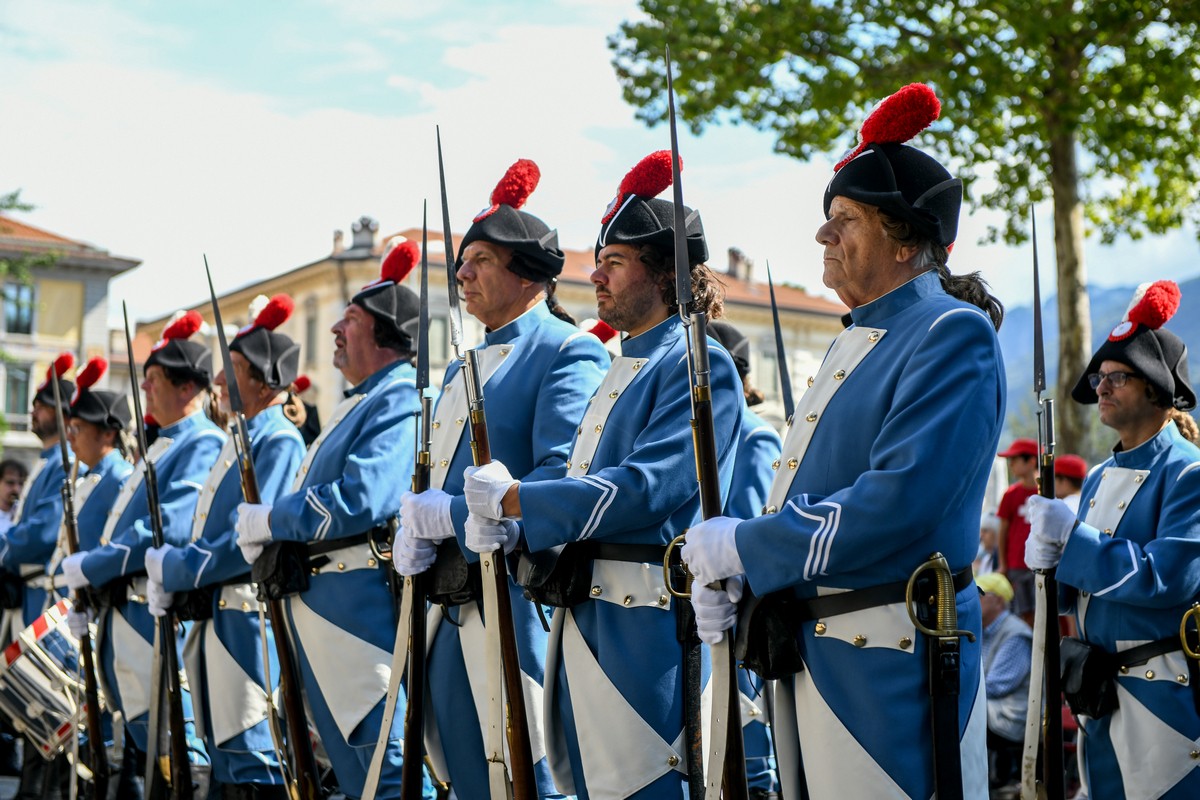
Become a volunteer
The Corpo Volontari Luganesi offers every citizen the chance to join this prestigious fellowship and help preserve the memory of the heroic deeds of the past, which opened the way to freedom for Lugano and the whole of Ticino.
The coat of arms
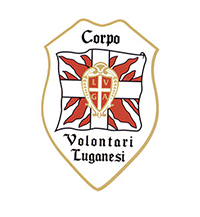
The coat of arms dates back to the Corps’ establishment in 1787. It depicts a white cross set against red flames, with the coat of arms of the City of Lugano in the centre. On the reverse appears Our Lady of Grace with the Child, patroness of the Corps.
The Italian Campaign
In 1796 Northern Italy was the scene of clashes between the army led by Napoleon Bonaparte and the forces of the Holy Roman Empire, the Papal States and the Kingdom of Sardinia. The fighting ended with Napoleon’s victory, and in 1797 he set up the Cisalpine Republic in the conquered territories. This also included the territory of the Duchy of Milan, very close to Lugano.
Because of its geography and strategic position, Napoleon considered Ticino a defensive bulwark, the gateway to Switzerland and, more generally, to the northern Alps. His intention, therefore, was to overthrow the Ancien Régime in the cantons and create a Helvetic Republic on the French model. The Ticino territories thus faced a choice: remain with the Confederates and await the outcome of the clash with Napoleon, or, after almost 300 years of subordination to Switzerland, join the new Cisalpine Republic, with which they had close ties.
The Swiss defensive strategy
To cope with the situation, the Diet meeting in Aarau sent a fully empowered delegation to the Italian bailiwicks to monitor revolutionary movements and train the population in the use of arms to defend against possible Cisalpine attacks.
Bailiff Jost Remy Traxler set up the Corpo Volontari Luganesi with about sixty members, the first nucleus for the defence of the town. It was supplied with a banner, 500 arquebuses and gunpowder, a gift from the Confederate cantons (at that time only 13).
Volunteers, revolutionaries and freedom
The creation of the Corpo Volontari Luganesi did not meet with unanimity; the Consiglio dei vicini of Lugano (roughly what we would today call a modest form of City Council) was sceptical, as was the town’s cultural élite, more attracted by revolutionary values than by loyalty to the bailiffs. It is therefore not surprising that many citizens of Lugano led the Cisalpine attack on Lugano on the night of 14–15 February 1798.
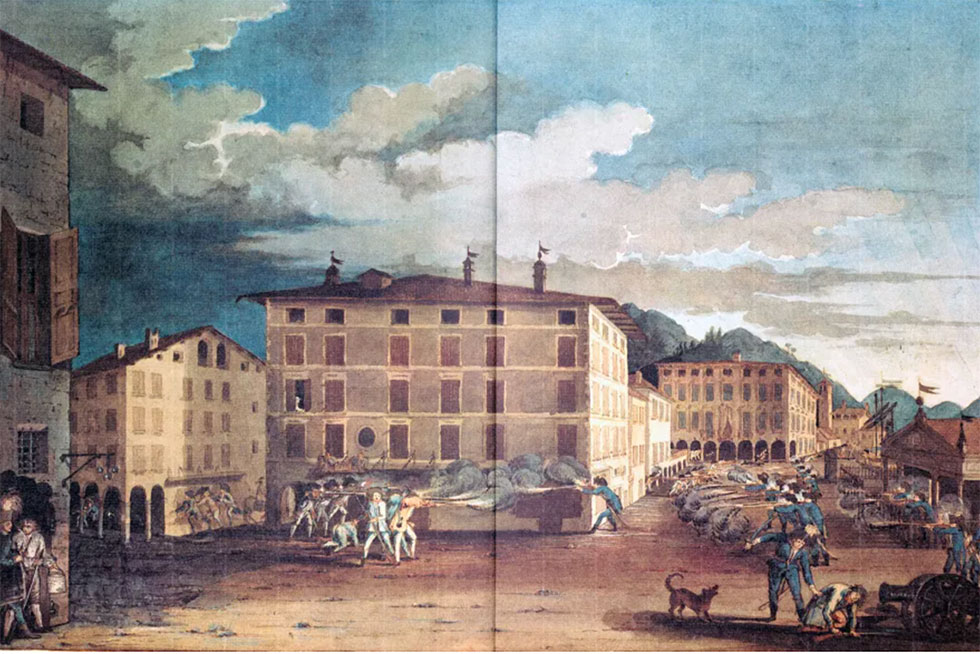
The Cisalpines even managed to take Bailiff Traxler hostage. But in a battle that lasted only one hour, and although outnumbered, the volunteers prevailed and drove the Cisalpines back. Three Cisalpines were killed, and only one volunteer: the young Giovanni Taglioretti.
Wasting no time, at five o’clock that same afternoon, a few hundred people—volunteers and townsfolk—gathered outside the Albergo Svizzero, where the Confederates were staying, to claim their right to be “Free and Swiss”. In Piazza della Riforma, then called Piazza Grande, they raised the liberty tree, but instead of crowning it with a Jacobin cap, they placed on top a cap like the one shown on William Tell.
Consequences
If Ticino, and especially the Sottoceneri, is today part of Switzerland rather than Italy, we owe it to that single one-hour battle fought by a small band against the Cisalpines. Paradoxically, we also owe it to Napoleon, who, after abandoning the idea of creating a Helvetic Republic on the French model, gave Switzerland a new constitution with the Act of Mediation of 1803.

Watercolours:
Insurrection of 15 February 1798, Rocco Torricelli, c. 1800
Lugano Volunteers in Piazza Grande (now Piazza della Riforma), Rocco Torricelli, c. 1800
Further information:
Listen to "The Battle of Lugano" on rsi.ch produced by Jonas Marti
Watch "Free and Swiss" on the YouTube channel produced by Jonas Marti
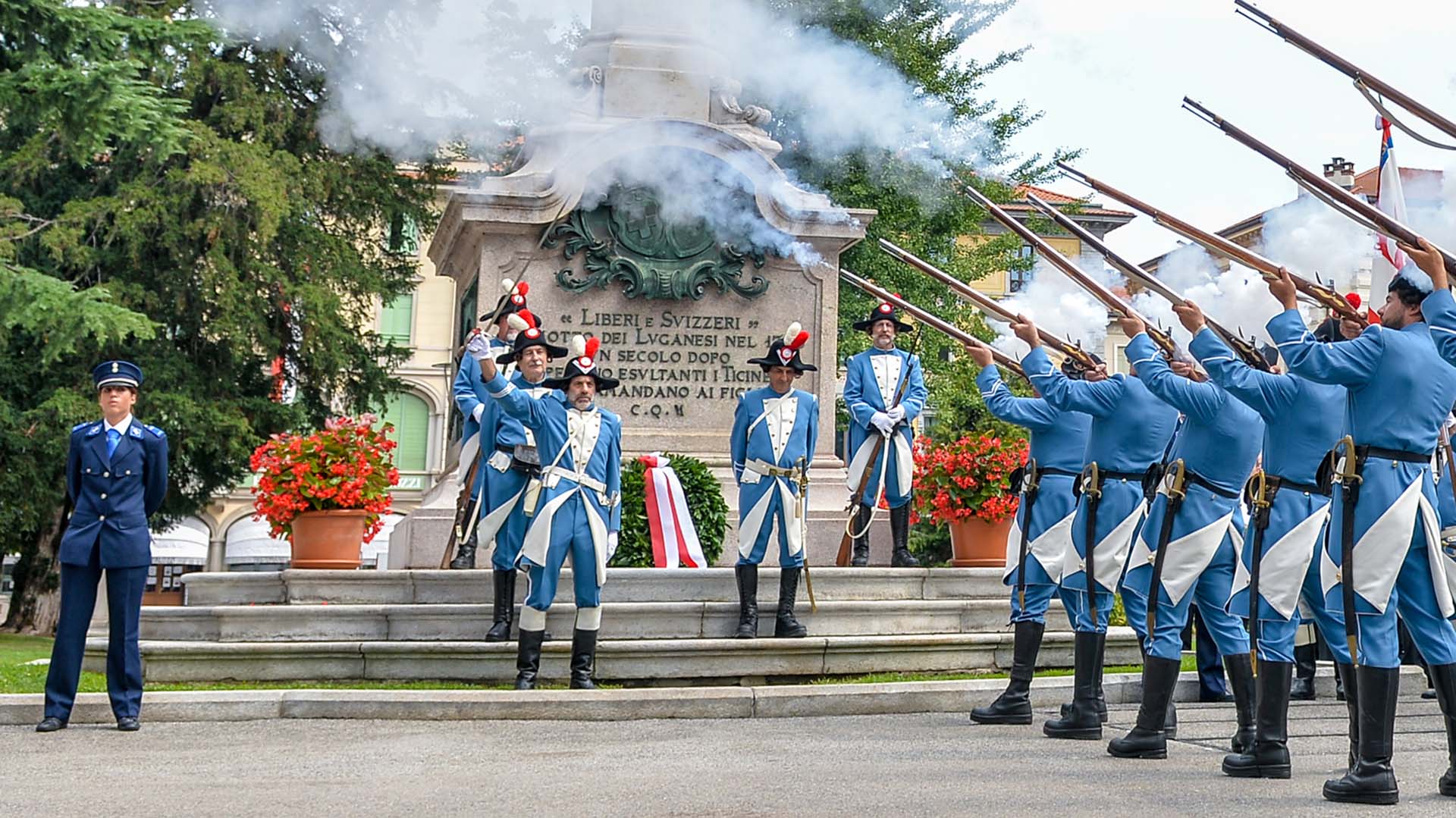
In memory of Giovanni Taglioretti, an epitaph can still be seen today on the walls of Via Canova: “Qui/fedele al giuramento/dei Volontari Luganesi/il 15 febbraio 1798/Giovanni Taglioretti/morì per la patria”. On every anniversary of his death and every first of August, Switzerland’s national day, a uniformed detachment of the Corpo Volontari lays a laurel wreath in Via Canova and at the Independence Monument.
Standing in the heart of Piazza Castello, now Piazza Indipendenza, the obelisk was erected in 1898 to mark the first centenary of Ticino’s independence. It bears the epigraph: “Liberi e Svizzeri/il motto dei Luganesi nel 1798/un secolo dopo/ripetono esultanti i Ticinesi/e tramandano ai figli/C(on) Q(uesto) M(onumento)".
Photo: Swiss National Day, 1° August 2023
1929 – 1943 - Commander Vegezzi Emilio - Deputy Commander Viglezio Egidio
1944 – 1947 - Commander Viglezio Egidio - Deputy Commander Bernasconi Emilio
1948 – 1956 - Commander Bernasconi Emilio - Deputy Commander Maestrini Leone
1957 – 1959 - Commander Poretti Pietro - Deputy Commander Maestrini Leone
1960 – 1971 - Commander Bernasconi Adriano - Deputy Commander Magnoli Bruno
1972 – 1977 - Commander Gianella Armando - Deputy Commander Destefani Paolo
1978 – 1979 - Commander Luvini Osvaldo - Deputy Commander Mordasini Luigi
1980 – 1995 - Commander Borradori Elio - Deputy Commander Mordasini Luigi
1996 – 1999 - Commander Borradori Elio - Deputy Commander Lombardi Rinaldo
2000 – 2012 - Commander Lombardi Rinaldo - Deputy Commander Scalena Flavio
2012 – today - Commander Romaneschi Sergio - Deputy Commanders Baiardi Paolo and Scalena Flavio
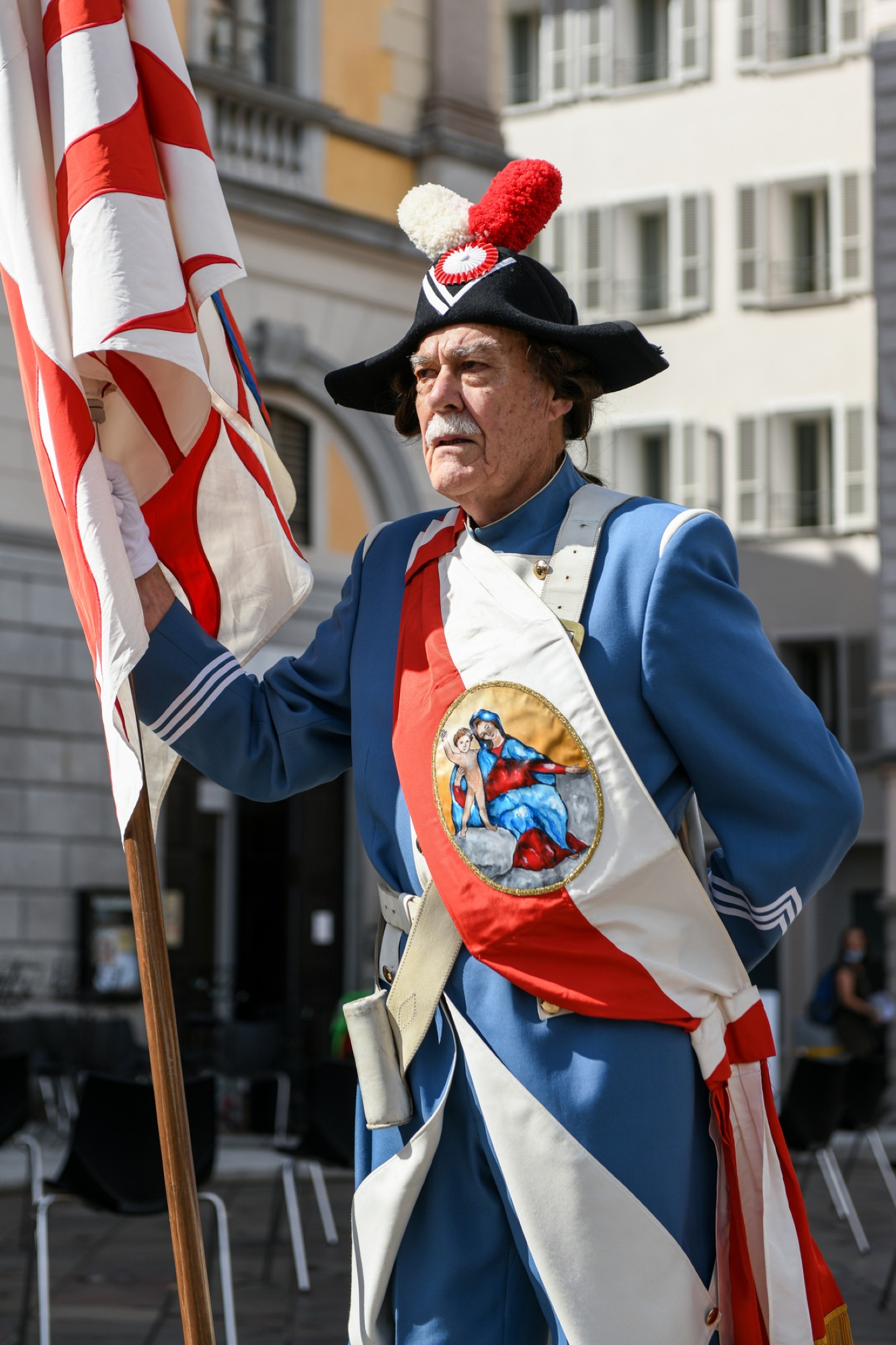
In recognition of their proven loyalty, the flag was one of the very first items the volunteers received—along with weapons and gunpowder—after the Corps was formed. The original flag, now tattered and patched, is kept in the parish house of the Cathedral of Saint Lawrence in Lugano. A second flag, sewn in 1898 by the Sisters of Saint Anne for the first centenary of the “Moti di Lugano”, is displayed on the Altar of Our Lady of Grace in the same cathedral.
Our Lady of Grace with the Child is the patroness of the Corpo Volontari Luganesi and is depicted on the flag opposite the coat of arms of the City of Lugano, placed at the centre of a white cross on red flames. Other flags followed, the most recent created for the Corps’ 200th anniversary.
The uniform, which greatly enhances the Corps’ legendary aura, was specified in an order of 31 May 1797: every volunteer was required to provide himself with a dark-blue coat lined in white, with white collar, edging and lapels, white buttons, a white waistcoat and dark-blue breeches. The hat bore a cockade and a red-and-white feather, and short Hungarian-style boots were worn. In fact, the white lapels were reserved for the town company (“the whites”), while the rural company volunteers (“the reds”) wore red lapels.
In the photo : Giovanni Ronchetti, Swiss National Day, 1° August 2021
The Corpo Volontari Luganesi continues to exist thanks to the support of the City of Lugano, the Aziende industriali di Lugano – AIL and Banca Stato.
Training, statute and activities
Today the Corps has 39 members. Its activities focus on historical, patriotic and cultural events, representing the City of Lugano. Thanks to the creation of a specialist unit trained to fire blank salutes with flintlock rifles, the Corps performs parade drills on major occasions, notably the New Year’s ceremony, the commemoration of the death of Giovanni Taglioretti on 15 February, and the Swiss National Day on 1° August.
Autumn Festival
The Corpo volontari luganesi will take part in the opening ceremony of the Festa d’Autunno 2025 (Autumn Festival 2025), scheduled for Friday, 3 October from 6:00 p.m., between Piazza della Riforma and the courtyard of the Town Hall. During the event it will be possible to view the historical uniform up close and see the Corps in action.
Programme of the day – Friday, 3 October 2025:
- 5:45 p.m. – Departure for the Town Hall
- 6:00 p.m. – Gathering in Piazza della Riforma, review
- About 7:00 p.m. – Salute shot in the Town Hall courtyard, followed by an aperitif
- About 8:00 p.m. – End of the aperitif and return to headquarters
The presence of the CVL at the Festa d’Autunno 2025 aims to reaffirm the bond with the city and offer residents and guests a moment to connect with history and collective memory.
Photo: Corpo Volontari Luganesi with Mayor Michele Foletti, Swiss National Day, 1° August 2023
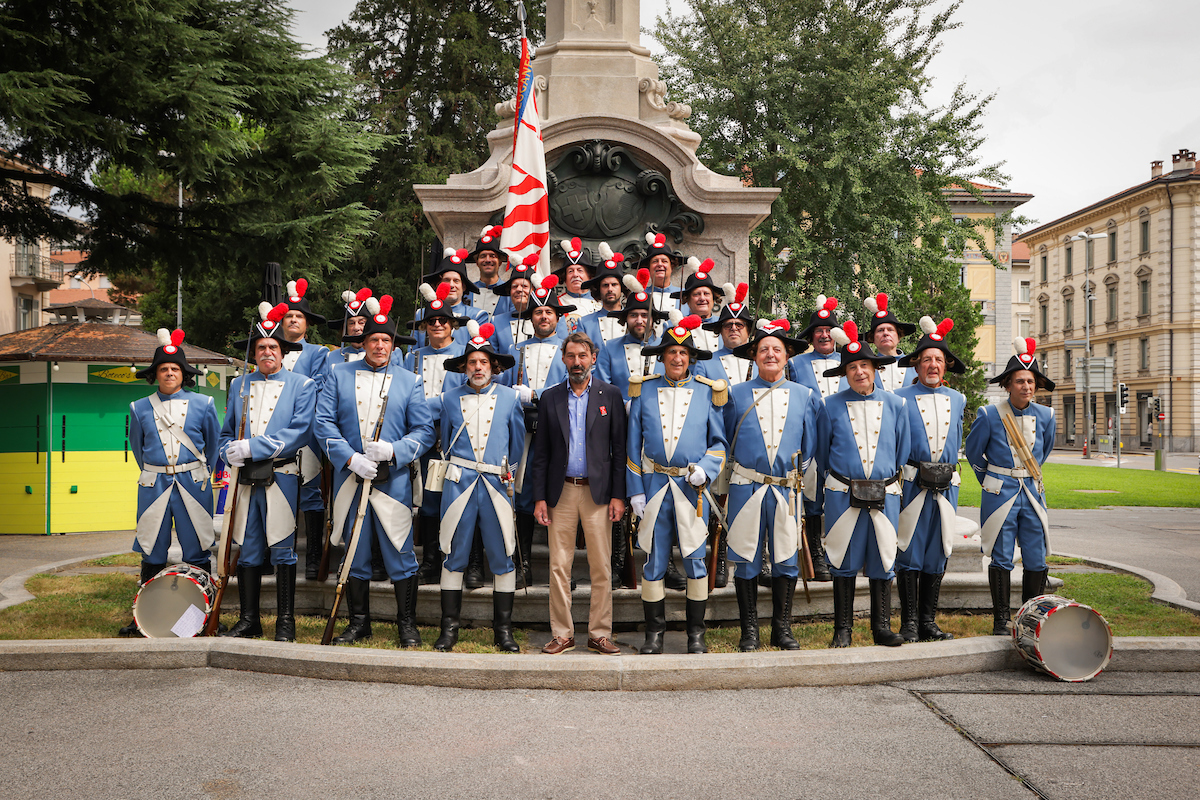
Organisation chart
Commander
Romaneschi Sergio
Deputy Commanders
Baiardi Paolo
Scalena Flavio
Quartermaster Sergeant
Rossini Piergiorgio
Sergeant major
Crivelli Andrea
Sergeants
Gobbin Lino
Lepori Mauro
Sirchia Fabio
Corporals
Alberti Giuliano
Buffolino Claudio
Zomer Luca
Senior privates
Cacciabue Giancarlo
Cimarolli Manuel
Guffanti Fabio
Hold Peter
Pettinaroli Felice
Rezzonico Antonio
Volunteers
Agostoni Paolo
Besseghini Marco
Bossola Patrick
Bonaglia Roberto
Dal Magro Fausto
De Luigi Alberto
Ferrari Ulisse
Foletti Gabriele
Gaggini Mauro
Grandi Andreas
Grumelli Daniel
Lorenzi Andrea
Luminati Carlo
Marti Jonas
Molinari Oliviero
Pfund Tito
Reggiori Sebastiano
Rezzonico Paolo
Schneidt Emilio
Tarchini Andrea
Tunesi Emilio
Tresoldi Christian
Valtulini Mirko
Video
Contacts
Corpo Volontari Luganesi
Via Istituto Rusca 13
6929 Gravesano
t. +41 79 211 69 82
[email protected]
The English version of this page was created with the aid of automatic translation tools and may contain errors and omissions.
The original version is the page in Italian.
